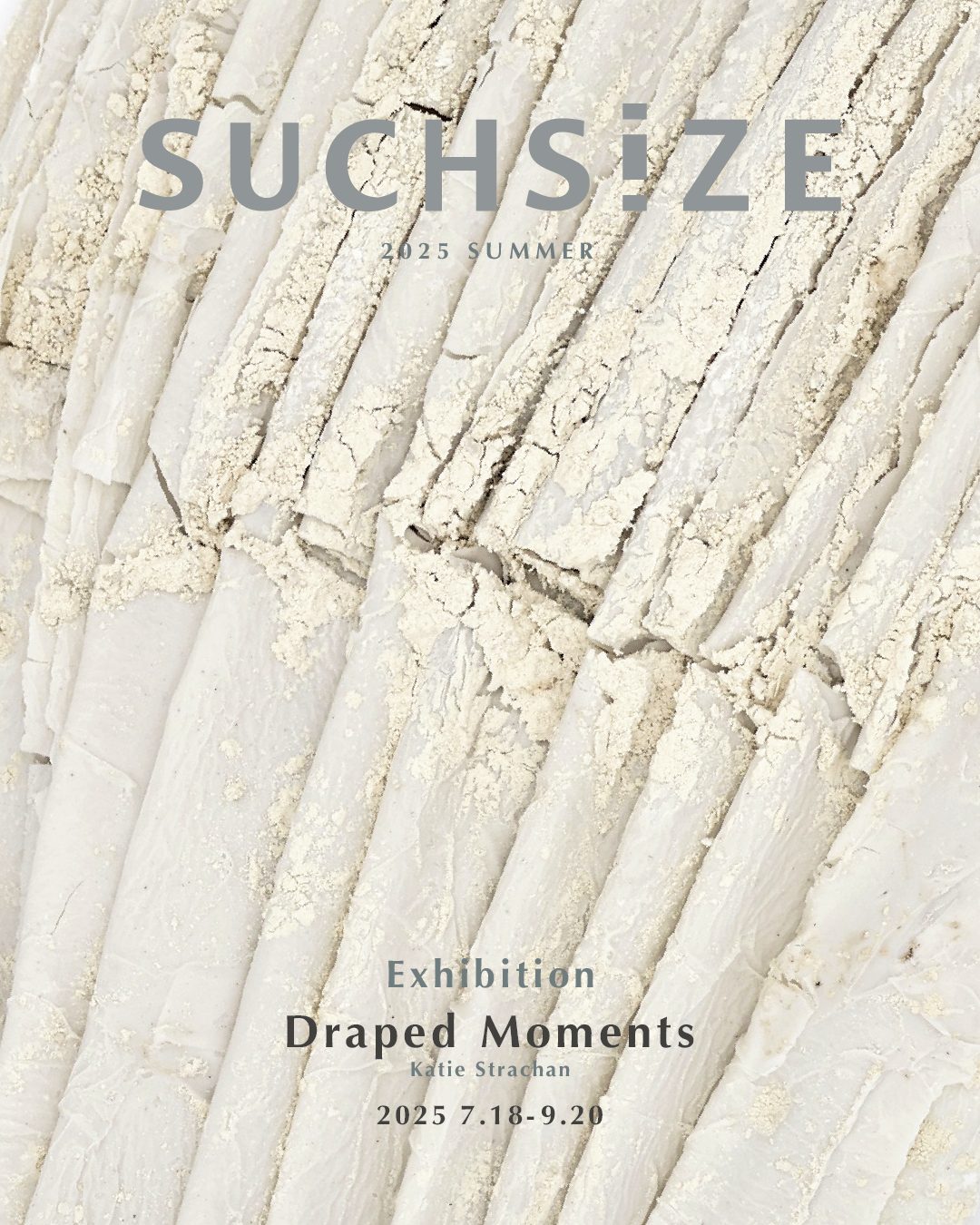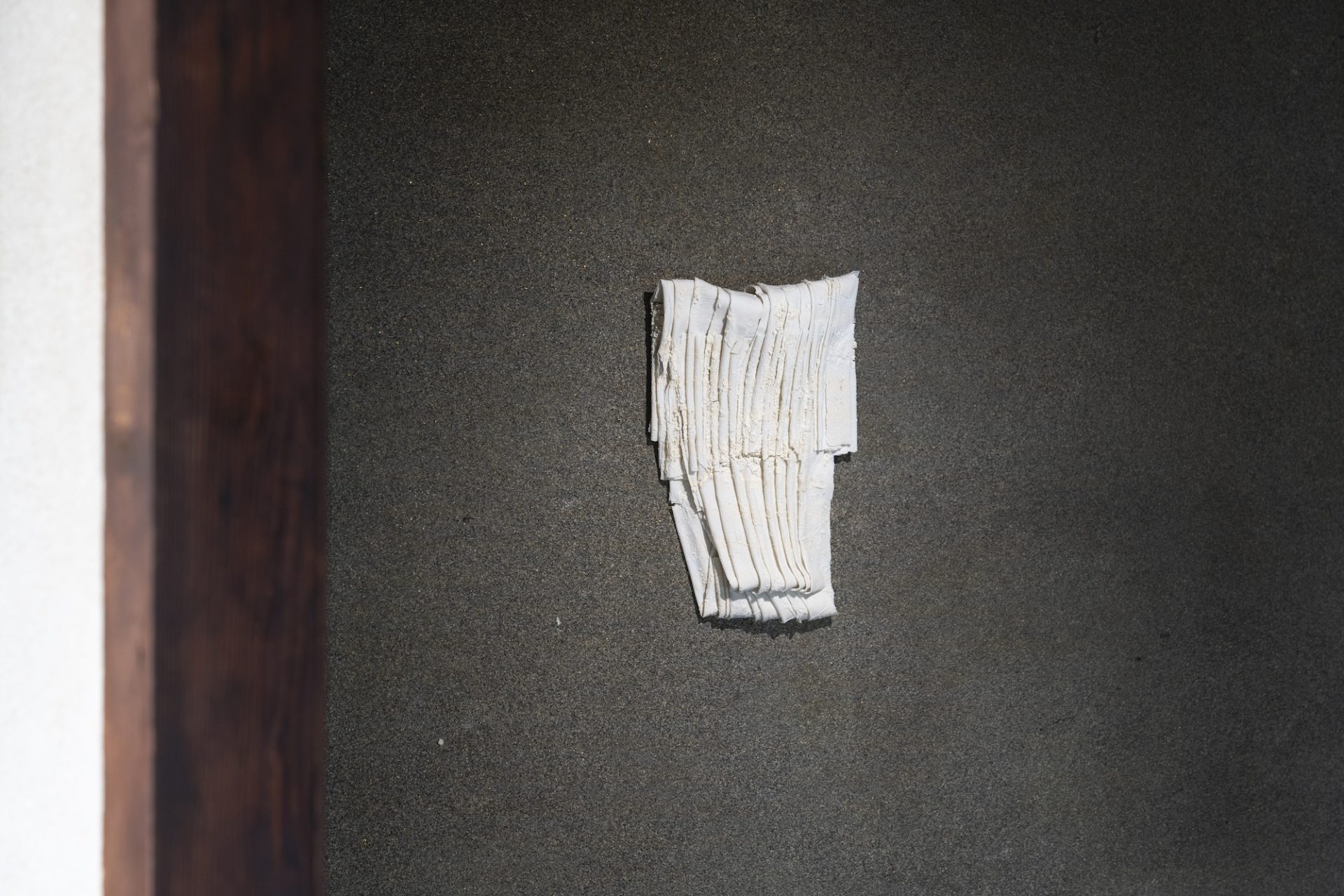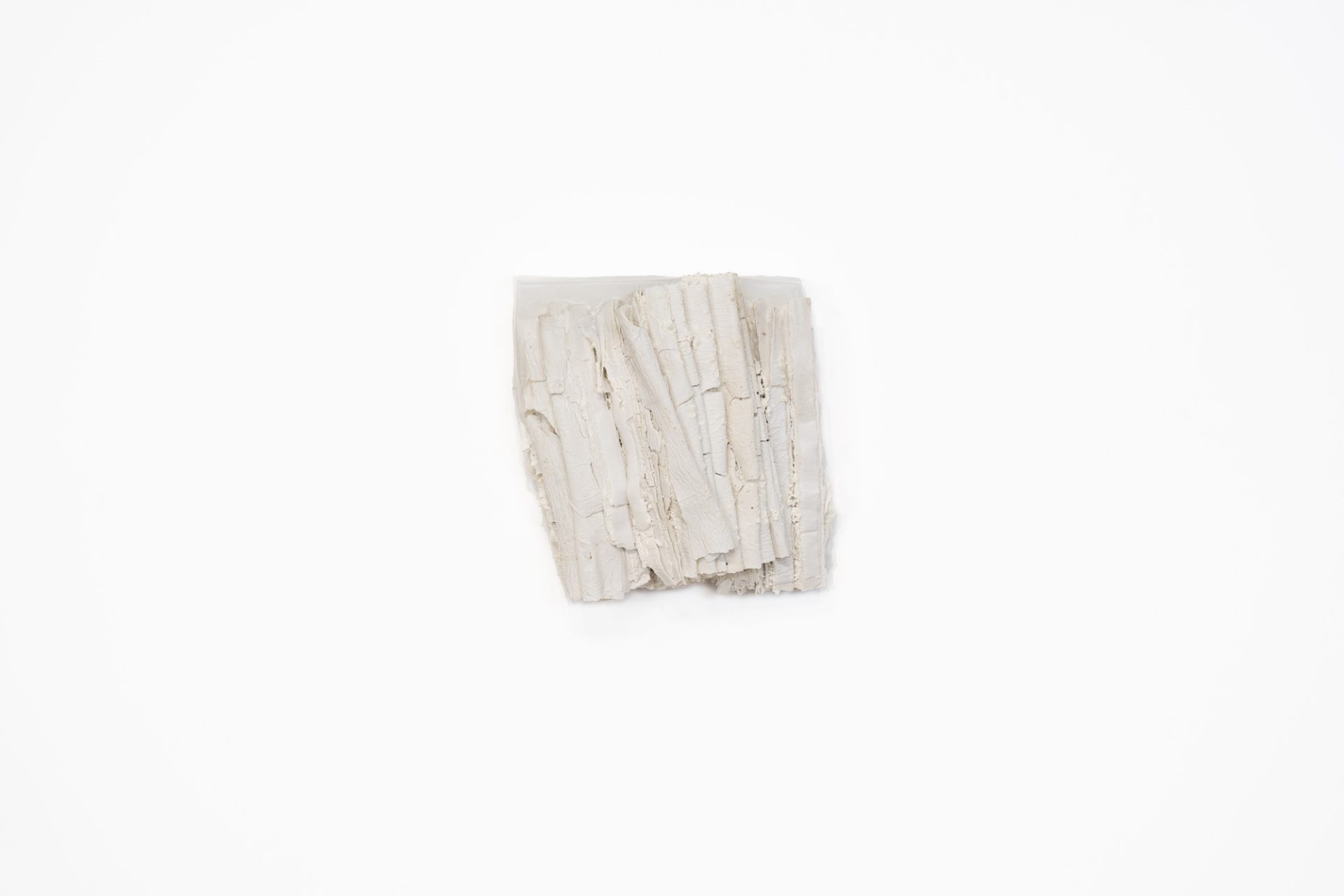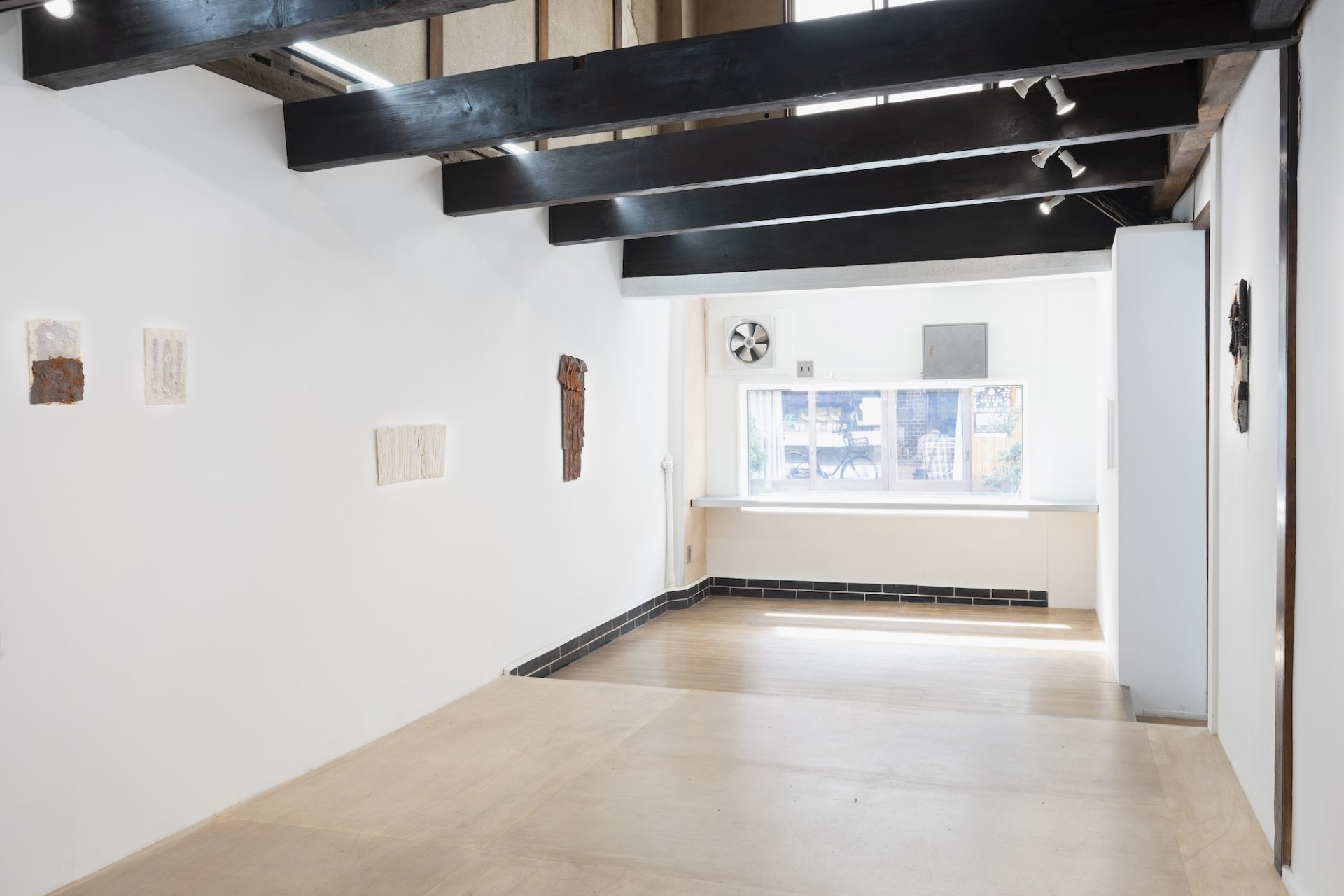2025年07月25日掲載
Draped Moments
SUCHSIZE
- 会期
- 2025年07月18日~2025年09月20日
カルーセル
2025年夏展では、民俗学者・田中忠三郎が収集した襤褸(ボロ)のように、「保存と崩壊の狭間で、時間の本質を表す遺物のような作品を通じて、私たちを異なる時間感覚の入口へと誘う」アーティストKatie Strachanを紹介します。
The 2025 Summer Exhibition, ‘Draped Moments’, introduces American artist Katie Strachan, whose practice spans sculpture, ceramics, and installation. Her work explores themes of impermanence and the passage of time, whether suggested by the fragility of her paper-thin clay surfaces or by the mixed materials she integrates, which conjure processes of erosion and decay. Drawing a curatorial parallel between Strachan’s work and boro textiles —Japanese artifacts whose history has been shaped by a similar philosophy of repair and renewal and whose surfaces quietly carry the weight of time—the exhibition invites viewers to reflect on the layered histories embedded in both material and memory.
Exhibition
会期:2025年7月18日(金)〜9月20日(土)のうちの金・土曜 *日〜木はアポイント承ります
時間:13:00〜18:00
会場:SUCHSIZE (大阪市西成区山王1-6-20)
料金:入場無料
出展作家:Katie Strachan (ケイト・ストラカン)
主催:SUCHSIZE 助成:大阪市
Dates: 18 July ー 20 September 2025 (Fridays, Saturdays is opened)
*By appointment Sunday through Thursday.
Time: 13:00 ー 18:00
Venue: SUCHSIZE
Admission: Free
Artist: Katie Strachan
Organized by: SUCHSIZE Supported by: City of Osaka
event
レセプション
日時:7月19日(土)17:00〜19:00
会場:SUCHSIZE
料金:入場無料
ケイト・ストラカン トークイベント
日時:8月23日(土)16:00〜17:30
会場:SUCHSIZE
料金:入場無料
※先着15名様は椅子席あり(予約不要)、日英逐次通訳あり
Reception
Date & Time: 19 July 2025 (Sat) 5:00–7:00 PM
Venue: SUCHSIZE
Admission: Free
Katie Strachan Talk Event
Date & Time: 23 August 2025 (Sat) 4:00–5:30 PM
Venue: SUCHSIZE
Admission: Free
*Seating available for the first 15 guests (no reservation required)
*Japanese–English consecutive interpretation provided
Statement
民俗学者・田中忠三郎が収集した襤褸(ボロ)は、単なる継ぎはぎの布や古着という形式を超え、私たちに数世代にわたる家族のつながりや、幾度も刺し継がれた刺し手の身体性を喚起し、はかなくも力強い継承の痕跡を宿しています。本夏展では、このボロのように、薄く延ばした陶土や粉状にした陶土の積層を通して、時間のはかなさと記憶の継承を表現するケイト・ストラカン (Katie Strachan)の作品を紹介し、無常の世界におけるモノを遺す行為について考えてみたいと思います。
粘土を布のように薄くし、時にはパウダー状にするなど、繊細で不定形な素材を使用するストラカンの陶は、丁寧な焼成を経て、脆さと強さという矛盾する存在感を同居させます。奥が透けるほど薄い層をドレープ状に重ねた《envelop》シリーズは、所々に裂け目が入り、作品内部を垣間見せます。これはあたかもボロの破れた隙間から先祖代々の布地が顔をのぞかせるかのようで、作家の無数の手業が断片的に現れ、身体的なエネルギーを遺しています。一方、《interval》シリーズは刺し子の運針を想起させる等間隔の切れ目をもち、装飾を極限まで削ぎ落としたミニマルな佇まいを見せます。この抑制された表現と、最小限の身振りで反復されるカッティングは、土という素材と炎の力を尊重する作家の姿勢であると同時に、無常の世界に対する受容を体現しています。
「作品は単なる物ではなく、遺物のように、異なる時間感覚への入口になり得る」と語るストラカンの眼差しのように、鑑賞者は作品を目の前にして、保存と崩壊が均衡する一瞬に立ち会っているかのような時間感覚をもちます。ボロにおいても、使用されていた過去の時代を想像させるだけでなく、使われてきた時間の総量が私たちの目に流れ込んできます。形あるすべてのものが崩壊し、循環し続ける無常の世界において、人が不可逆的な時間の流れの中でモノの形をとどめようとすること。それ自体が、自然の摂理とは異なる時間と向き合う行為と言えるでしょう。
手のひらの携帯電話が記憶の断片を紡ぎ出し、物が壊れる以前に新調する現代だからこそ、ストラカンの陶は遺物を目指し、悠久の時と添い遂げようとします。今にも壊れそうな瞬間が凝縮されたまま遺り続けるという、一瞬と永遠が同居する作品のイメージを携えて、私たちに無常の世界で生きているのだとささやくのです。
----------
田中忠三郎(1933–2013年)は、青森県を拠点に活動した独学の民俗学者・民俗民具研究家で、特に「ボロ」と呼ばれる繕い継がれた布地をはじめとする民具の収集と研究で知られています。キャリアの初期には縄文遺跡の発掘に携わり、その後は江戸時代から昭和期の日常生活用品を体系的に収集・保存して約3万点のコレクションを築き、そのうち786点が国の重要有形民俗文化財に指定されています。
More than patched cloth and repurposed fabric scraps, boro textiles carry the imprint of multi-generational family ties and the embodied presence of the hands that stitched and mended them. Each layer bears quiet yet powerful traces of inheritance and care. Echoing this sentiment, the work of Katie Strachan reflects on the transience of time, the transmission of memory, and the impulse to leave something behind in the face of inevitable change.
Strachan thins clay to become as delicate as fabric, at times rendering it into powder, and creating materials that are fragile and amorphous. The process of layering and folding these thin sheets echoes the repetition of hand-stitched embroidery, suggesting a slow accumulation of time. Through careful firing, her ceramics embody the simultaneous presence of fragility and strength—seemingly contradictory yet coexisting.
In the series envelop, layers of clay—so thin they become translucent—are draped and folded, allowing glimpses of the sculptures’ inner form through tears, much like ancestral fabrics revealing themselves through the worn gaps of boro cloth. Countless visible and invisible marks across the surfaces reveal the artist’s presence, conveying the care and energy involved in their making. Meanwhile, the series interval feature evenly spaced cuts on clay, also reminiscent of the running stitches of sashiko—another core element of boro mending. Here, the works present an austere, minimalist presence, stripped of all ornamentation. Made without glaze or colorant, the pieces feature repetitive incisions executed with the barest of gestures. During firing, these cuts fracture and reveal the clay’s powdery interior. Strachan’s restrained expression and repetitive acts speak to a reverence for the physical process of transformation, as well as an acceptance of the ever-changing nature of all things.
In Strachan’s words, “Artworks are not merely objects; they can serve as gateways to different perceptions of time, like relics.” In front of her works, viewers come to inhabit a sense of temporality in which preservation and decay are held in delicate balance, as if witnessing a fleeting moment suspended between the two. Similarly, boro textiles evoke not only the era in which they were used, but the cumulative span of time they have endured through generations of use, visible to the eye. In this mutable world, where all material things eventually decay and cycle anew, the very act of preserving form amid the irreversible flow of time becomes a way of confronting a temporality beyond natural order.
In today’s world—where the smartphones in our palms spin out fragments of memory, objects are discarded before they show signs of wear—Strachan’s ceramics aspire to become relics, seeking to accompany the endless flow of time. Carrying the image of where the fleeting and the timeless meet, Stratchan’s works remain suspended in fragile tension, quietly whispering to us that we live within a world shaped by impermanence.
----------
Boro refers to traditional Japanese textiles that originated in the rural, working-class communities of Japan’s northern regions. Created over generations through hand-dyeing, patching, and layering worn fabric scraps, these household textiles embody a philosophy of repair, resilience, and renewal. They are characterised by visible stitching and an aesthetic of imperfection and weathering associated with wabi-sabi. Though originally born of necessity, boro has since been embraced as a form of folk art and tangible cultural heritage, inspiring contemporary artists and designers who draw on its legacy to explore themes of transience and sustainability.
Katie Strachan | ケイト・ストラカン (Philadelphia, United States)
彫刻、陶芸、そして素材を活かしたインスタレーションを中心に活動するアメリカ人アーティスト。極薄の粘土層を重ねる陶芸の技法に、蝋、フェルト、木材などの素材を組み合わせ、作品を通して無常や時間の経過を探求する。ストラカンの背景には、ペンシルベニア・ジャーマンのフラクトゥール写本の伝統があり、作品を通して物体とテキスト、遺物と記録の境界を曖昧にしている。
ストラカンは、ニューヨーク州立ファッション工科大学でファイバーを専攻し学士号を取得し、金沢での陶芸修業を経て、台湾の国立台南芸術大学で修士号を取得。2023年には、NCECA Emerging Artist Award、2021年にはBlanc de Chine International Ceramic Art Awardにて第3位を受賞している。https://www.katestrachan.com/
Rooted in the Pennsylvania German Fraktur tradition, Katie Strachan’s practice merges sculpture, ceramics, and installation to create layered forms that hold traces of memory, ritual, and decay. With a background in fiber and ceramics, Strachan merges material sensitivity with conceptual intent, often blurring the boundary between object and text, relic and record.
Strachan holds a BFA in Fiber from the Fashion Institute of Technology (F.I.T.) in New York. She began her ceramic training as an apprentice in Kanazawa, Japan, before completing her MFA at Tainan National University of the Arts (TNNUA) in Taiwan. She is the recipient of the 2023 NCECA Emerging Artist Award and Third Prize in the 2021 Blanc de Chine International Ceramic Art Award. She has participated in artist residencies at the European Ceramic Work Centre (EKWC) in the Netherlands and the Shigaraki Ceramic Cultural Park in Japan, both supported by their respective national governments.
- 展覧会名
- Draped Moments
- 分類
- 企画展
- 会場
- SUCHSIZE
- 会期
- 2025年07月18日~2025年09月20日 Googleカレンダーに登録📅
- 開館時間
- 13:00〜18:00
- 休館日
- 日曜日〜木曜日
- 観覧料
- 無料
- 住所
-
557-0001 大阪府大阪市西成区山王1-6-20
- アクセス
- 大阪メトロ御堂筋線/堺筋線 「動物園前駅」2番出口 徒歩5分
JR新今宮駅、天王寺駅 徒歩8分 - 公式サイト
- https://www.suchsize.com/blog/2025/07/09/164525
- 公式SNS









